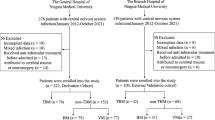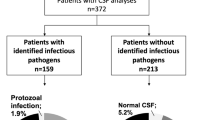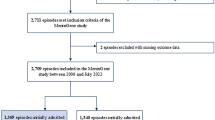Abstract
Objective
To determine whether bacterial (BM) and viral (VM) meningitis can be differentiated based on initial clinical presentation.
Design and setting
Retrospective cohort study in a medical emergency department and intensive care unit in a university hospital.
Patients
144 adults, including 90 with confirmed BM and 54 unpretreated VM.
Measurements and results
Symptoms, examination findings, paraclinical data, and clinical outcome were assessed. Severity was defined by the presence at referral of one of the following criteria: altered consciousness, seizures, focal neurological findings, and shock. After univariate analyses we performed stepwise logistic regression to determine predictors for BM available at referral (except for CSF Gram stain) and logistic regression using previously validated CSF cutoffs. Univariate methods identified the presence of one sign of severity as the most important predictor for BM (sensitivity 0.989, specificity 0.981, positive predictive value 0.989, negative predictive value 0.981, odds ratio 4,770) and showed that CSF results differ in BM and in VM (except for CSF glucose). Logistic regression analysis revealed severity and CSF absolute neutrophil count as the two predictors of BM (R2=0.876). Logistic analysis showed that BM was related to severity (β=6.46±1.27) and a CSF absolute neutrophil count above 1,000/mm3 whereas CSF glucose below 2 mmol/l and CSF protein higher than 2 g/l were not predictive.
Conclusions
The presence of at least one sign of severity at referral and a CSF absolute neutrophil count above 1,000/mm3 mm are predictive of BM.


Similar content being viewed by others
References
Attia J, Hatala R, Cook DJ, Wong JG (1999) Does this adult patient have acute meningitis? JAMA 282:175–181
Genton B, Berger JP (1988) Les méningites de l’adulte au Centre Hospitalier Vaudois: diagnostic, prise en charge et évolution de 112 cas. Rev Med Suisse Romande 108:795–803
Flores-Cordero JM, Amaya-Villar R, Rincon-Ferrari M, Leal-Noval SR, Garnacho-Montero J, Llanas-Rodriguez AC, Murillo-Cabezas F (2003) Acute community acquired bacterial meningitis in adults admitted to the intensive care unit, clinical manifestations, management and prognostic factors. Intensive Care Med 29:1967–1973
Durand ML, Calderwood SB, Weber DJ, Miller SI, Southwick FS, Caviness VS, Swartz MN (1993) Acute bacterial meningitis in adults. A review of 493 episodes. N Engl J Med 328:21–28
Hussein AS, Shafran SD (2000) Acute bacterial meningitis in adults. A 12-year review. Medicine (Baltimore) 79:360–368
Tang LM, Chen ST, Hsu WC, Lyu Rk (1999) Acute bacterial meningitis in adults: a hospital based epidemiological study. Q J Med 92:719–725
Odetola FO, Bratton SL (2005) Characteristics and immediate outcome of childhood meningitis treated in the pediatric intensive care unit. Intensive Care Med 31:92–97
Spanos A, Harrell FE Jr, Durack DT (1989) Differential diagnosis of acute meningitis. An analysis of the predictive value of initial observations. JAMA 262:2700–2707
McGee ZA, Kaiser AB (1985) Acute meningitis. In: Mandell GL, Douglas RG, Bennet JE (eds) Principles and practice of infectious disease, 2nd edn. Wiley, New York, pp 560–573
Feigin RD, Schackelford PG (1973) Value of repeat lumbar puncture in the differential diagnosis of meningitis. N Engl J Med 289:571–574
Amir J, Harel L, Frydman M, Handsher R, Varsano I (1991) Shift of cerebrospinal polymorphonuclear cell in the early stage of aseptic meningitis. J Pediatr 119:938–941
Negrini B, Kelleher KJ, Wald ER (2000) Cerebrospinal fluid findings in aseptic versus bacterial meningitis. Pediatrics 105:316–319
Barone MA (1999) Laboratory values. In: McMillan JA, De Angelis CP, Feigin RD, Warshaw JD (eds) Oski’S pediatrics: principle and practice, 3rd edn. Lippincot Williams Wilkins, New York, pp 2225
Legall JR, Lemeshow S, Saulnier F (1993) A New Simplified Acute Physiology Score (SAPS II) based on an European North American multicenter study. JAMA 270:2957–2963
Members of the American College of Chest Physicians / Society of Critical Care Medicine Consensus Conference (1992) Definition for sepsis and organ failure and guidelines for the use of innovative therapies in sepsis. Crit Care Med 20:864–874
Strikas RA, Anderson LJ, Parker RA (1986) Temporal and geographic patterns of isolates of nonpolio enteroviruses in the United States 1970–1983. J Infect Dis 153:346–351
Nigrovic LE, Kuppermann N, Malley R (2002) Development and validation of a multivariate predictive model to distinguish bacterial from aseptic meningitis in children in the post Haemophilus influenzae era. Pediatrics 110:712–719
Elmore JG, Horwitz RI, Quagliarello VJ (1996) Acute meningitis with a negative Gram’s stain: clinical and management outcomes in 171 episodes. Am J Med 100:79–84
Bonadio WA (1992) The cerebrospinal fluid physiologic aspects and alterations associated with bacterial meningitis. Pediatr Infect Dis J 11:423–432
Tunkel AR, Scheld WM (1995) Acute bacterial meningitis. Lancet 346:1975–1980
Power WJ (1985) Cerebrospinal fluid lymphocytosis in acute bacterial meningitis. Am J Med 79:216–220
Baty V, Viel JF, Schuhmacher H, Jaeger F, Hoen B (2000) Prospective validation of diagnosis model as an aid to therapeutic decision-making in acute meningitis. Eur J Clin Microbiol Infect Dis 19:422–426
Jaeger F, Leroy J, Duchêne F, Baty V, Baillet JM, Hoen B (2000) Validation of a diagnosis model for differentiating bacterial from viral meningitis in infants and children under 3.5 years of age. Eur J Clin Microbiol Infect Dis 19:418–421
Hoen B, Viel JF, Paquot C, Gerard A, Canton P (1995) Multivariate approach to differential diagnosis of acute meningitis. Eur JClin Microbiol Infect Dis 14:267–274
Bonsu BK, Harper MB (2004) Differentiating acute bacterial meningitis from acute viral meningitis among children with cerebrospinal fluid pleocytosis. A multivariate regression model. Pediatr Infect Dis J 23:511–517
Oostenbrink R, Mooms KG, Donders AR, Grobbee DE, Moll HA (2001) Prediction of bacterial meningitis in children with meningeal signs: reduction of lumbar punctures. Acta Paediatr 90:611–617
Tokuda Y (2000) Bacterial versus viral meningitis: comparison of the old and the new clinical prediction models (abstract). Crit Care [Suppl 1]:183
Thomas KE, Hasbun R, Jekel J, Quagliarello VJ (2002) The diagnosis accuracy of Kernig’s sign, Brudzinski’s sign and nuchal rigidity in adults with suspected meningitis. Clin Infect Dis 35:46–52
Kleine TO, Zwerenz P, Zöfel P, Shiratori K (2003) New and old diagnostic markers of meningitis in cerebrospinal fluid (CSF). Brain Res Bull 61:287–297
Aronin SI, Peduzzi P, Quagliarello VJ (1998) Community acquired bacterial meningitis: risk stratification for adverse clinical outcome and effect of antibiotic timing. Ann Intern Med 129:862–869
Behrman RE, Meyers BR, Mendelson MH, Sacks HS, Hirschman SZ (1989) Central nervous system infections in the elderly. Arch Intern Med 149:1596–1599
Van de Beek D, de Gans J, Spanjaard L, Weisfelt M, Reitsma JB, Vermeulen M (2004) Clinical features and prognostic factors in adults with bacterial meningitis. N Engl J Med 351:1849–1859
Magnussen CR (1980) Meningitis in adults: ten-year retrospective analysis at community hospital. NY State J Med 80:901–906
Zimmerli W (2003) Acute bacterial meningitis: time for a better outcome. Intensive Care Med 29:1868–1870
Andrews P, Azoulay E, Antonelli M, Brochard L, Brun-Buisson C, Dobb G, Fagon JY, Gerlach H, Groenveld J, Mancebo J, Metnitz P, Nava S, Pugin J, Pinsky M, Radermacher P, Richard C, Taster R, Vallet B (2005) Year in intensive care medicine, 2004 III. Outcome, ICU organization, scoring, quality of life, ethics, psychological problems and communication in the ICU, immunity and hemodynamic during sepsis, pediatric and neonatal critical care, experimental studies. Intensive Care Med 31:356–372
Whitney CG, Farley MM, Harrison LH, Bennet NM, Lynfield R, Reingold A, Cieslack PR, Pilishvili T, Jackson D, Facklam RR, Jorgensen JH, Schuchat A active bacterial core surveillance of the emerging infections program network (2003) Decline in invasive pneumococcal disease after the introduction of protein-polysaccharide conjugate vaccine. N Engl J Med 348:1737–1746
Mégarbane B, Marchal P, Marfaing-Koka A, Belliard O, Jacobs F, Chary I, Brivet FG (2004) Increased diffusion of soluble adhesion molecules in meningitis, severe sepsis and systemic inflammatory response syndrome without neurological infection is associated with intrathecal shedding in case of meningitis. Intensive Care Med 30:867–874
Author information
Authors and Affiliations
Corresponding author
Additional information
This article is discussed in the editorial available at: http://dx.doi.org/10.1007/s00134-005-2810-2
Rights and permissions
About this article
Cite this article
Brivet, F.G., Ducuing, S., Jacobs, F. et al. Accuracy of clinical presentation for differentiating bacterial from viral meningitis in adults: a multivariate approach. Intensive Care Med 31, 1654–1660 (2005). https://doi.org/10.1007/s00134-005-2811-1
Received:
Accepted:
Published:
Issue Date:
DOI: https://doi.org/10.1007/s00134-005-2811-1




